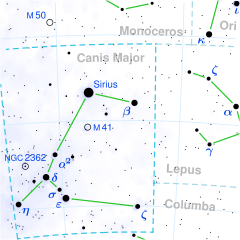弧矢一
弧矢一,即大犬座δ (Delta CMa, δ CMa, Wezen)[10],是一颗位于大犬座的恒星,它是一颗视星等为+1.83的黄-白F型超巨星。自1943年以来,这颗恒星的光谱已成为其他恒星分类的稳定参考点之一[11]。
| 觀測資料 曆元 J2000 | |
|---|---|
| 星座 | 大犬座 |
| 星官 | |
| 赤經 | 07h 08m 23.48608s[1] |
| 赤緯 | −26° 23′ 35.5474″[1] |
| 視星等(V) | 1.824[2] |
| 特性 | |
| 光谱分类 | F8 Ia[3] |
| U−B 色指数 | +0.584[2] |
| B−V 色指数 | +0.691[2] |
| 变星类型 | ?[4] |
| 天体测定 | |
| 徑向速度 (Rv) | 34.3 ± 0.9[5] km/s |
| 自行 (μ) | 赤经:–3.12[1] mas/yr 赤纬:+3.31[1] mas/yr |
| 视差 (π) | 2.03 ± 0.38[1] mas |
| 距离 | approx. 1,600 ly (approx. 490 pc) |
| 绝对星等 (MV) | –6.86[6] |
| 詳細資料 | |
| 質量 | 16.9 ± 1.6[3] M☉ |
| 半徑 | 215 ± 66[7] R☉ |
| 表面重力 (log g) | 1.00 ± 0.14[3] |
| 亮度 | 82,000[6] L☉ |
| 溫度 | 6,390 ± 150[3] K |
| 金属量 [Fe/H] | 0.24[8] dex |
| 自轉速度 (v sin i) | 25[9] km/s |
| 年齡 | 12[3] Myr |
| 其他命名 | |
| 參考資料庫 | |
| SIMBAD | 资料 |
可见度
编辑弧矢一是大犬座内第三明亮的恒星,仅次于大犬座α(天狼星)和大犬座ε(弧矢七),视星等为+1.83,呈白色或黄白色。它位于天狼星东南偏南方向,距离约为10度,如果在英国附近的纬度上观测它,那么它最高只会升起至比地平线高11度的位置[12]。疏散星团NGC 2354位于其以东仅1.3度的位置。[13] 与大犬座的其他天体一样,其最佳观测时间是北半球的冬季和南半球的夏季。在拜耳绘制的星图中,弧矢一位于大犬的后四分之一[14]。
历史和命名
编辑弧矢一(拉丁语为Delta Canis Majoris)的名字来自于拜耳命名法。
它在西方的传统名字为Wezen(也称 Wesen, 或者 Wezea),来源于阿拉伯语 وزن al-wazn,意为重量。在阿拉伯语中,这个名字是一对恒星中的一个,另一个是Hadar(意为土壤),如今是半人马座β的名字。目前还不清楚这对恒星最初是指半人马座α和β还是天鸽座α和β。不过无论如何,这个名字以某种方式适用于大犬座δ和天鸽座β[15]。Richard Hinckley Allen认为这个名字代表了这颗恒星在北半球升起至地平线以上的难度[14]。天文学家吉姆·凯勒曾提出考虑到其质量,这个名字也很适合于该恒星[16]。
2016年,国际天文联合会组织了一个IAU恆星名稱工作組(WGSN)[17],为恒星编制名称并使名称标准化。其在2016年7月的第一份公告[18]中包含了由WGSN批准的前两批名称的表格,其中就包括了Wezen这颗恒星。
在中国,弧矢(Hú Shǐ)代表着弓和箭[19],指由大犬座δ(弧矢一)、大犬座η(弧矢二)、船尾座c(弧矢三)、船尾座χ(弧矢四)、船尾座ο(弧矢五)、船尾座k(弧矢六)、大犬座ε(弧矢七)、大犬座κ(弧矢八)和船尾座π(弧矢九)这九颗星组成的星官。因此外语环境中的“大犬座δ”在中文亦称为弧矢一(Hú Shǐ yī, 英語:the First Star of Bow and Arrow)[20]。
特征
编辑弧矢一是一颗F8型的超巨星,其半径约为太阳的215倍,表面温度约为5,818 K[21],质量约为太阳的17倍,绝对星等为-6.78[6],距离地球约1600光年。如果弧矢一距离地球和天狼星一样近的话,那它将有半个满月那么亮[22]。它以48公里每秒的速度自转,因此可能需要一年的时间才能自转一周。弧矢一只有一千万年的历史,并且在其核心已经停止了氢聚变。由于其核心合成了更重的元素,它的外壳开始膨胀并冷却,在接下来的十万年里将变为一颗红色超巨星。当核心聚变为铁时,它将崩溃并爆炸,成为一颗超新星[16]。
现代遗产
编辑参考资料
编辑- ^ 1.0 1.1 1.2 1.3 1.4 van Leeuwen, F. Validation of the new Hipparcos reduction. Astronomy and Astrophysics. November 2007, 474 (2): 653–664. Bibcode:2007A&A...474..653V. arXiv:0708.1752 . doi:10.1051/0004-6361:20078357.
- ^ 2.0 2.1 2.2 Gutierrez-Moreno, Adelina; et al. A System of photometric standards. Publ. Dept. Astron. Univ. Chile (Publicaciones Universidad de Chile, Department de Astronomy). 1966, 1: 1–17. Bibcode:1966PDAUC...1....1G.
- ^ 3.0 3.1 3.2 3.3 3.4 Lyubimkov, Leonid S.; et al. Accurate fundamental parameters for A-, F- and G-type Supergiants in the solar neighbourhood. Monthly Notices of the Royal Astronomical Society. February 2010, 402 (2): 1369–1379. Bibcode:2010MNRAS.402.1369L. arXiv:0911.1335 . doi:10.1111/j.1365-2966.2009.15979.x.
- ^ Koen, Chris; Eyer, Laurent. New periodic variables from the Hipparcos epoch photometry. Monthly Notices of the Royal Astronomical Society. 2002, 331 (1): 45–59. Bibcode:2002MNRAS.331...45K. ISSN 0035-8711. arXiv:astro-ph/0112194 . doi:10.1046/j.1365-8711.2002.05150.x.
- ^ Evans, D. S. Batten, Alan Henry; Heard, John Frederick , 编. The Revision of the General Catalogue of Radial Velocities. Determination of Radial Velocities and their Applications (University of Toronto: International Astronomical Union). June 20–24, 1966, 30: 57. Bibcode:1967IAUS...30...57E.
|booktitle=被忽略 (帮助) - ^ 6.0 6.1 6.2 Arellano Ferro, A.; Giridhar, S.; Rojo Arellano, E. A Revised Calibration of the MV-W(O I 7774) Relationship using Hipparcos Data: Its Application to Cepheids and Evolved Stars. Revista Mexicana de Astronomía y Astrofísica. April 2003, 39: 3–15. Bibcode:2003RMxAA..39....3A. arXiv:astro-ph/0210695 .
- ^ Davis, J.; et al. The Emergent Flux and Effective Temperature of δ Canis Majoris. Publications of the Astronomical Society of Australia. October 2007, 24 (3): 151–158. Bibcode:2007PASA...24..151D. arXiv:0709.3873 . doi:10.1071/AS07017.
- ^ Prugniel, Ph.; Vauglin, I.; Koleva, M. The atmospheric parameters and spectral interpolator for the MILES stars. Astronomy & Astrophysics. July 2011, 531: A165. Bibcode:2011A&A...531A.165P. arXiv:1104.4952 . doi:10.1051/0004-6361/201116769.
- ^ Bernacca, P. L.; Perinotto, M. A catalogue of stellar rotational velocities. Contributi Osservatorio Astronomico di Padova in Asiago. 1970, 239 (1): 1. Bibcode:1970CoAsi.239....1B.
- ^ IAU Catalog of Star Names. [28 July 2016]. (原始内容存档于2018-07-07).
- ^ Garrison, R. F. Anchor Points for the MK System of Spectral Classification. Bulletin of the American Astronomical Society. December 1993, 25: 1319 [2012-02-04]. Bibcode:1993AAS...183.1710G. (原始内容存档于2019-06-25).
- ^ Mobberly, Martin. The Caldwell Objects and How to Observe Them. Springer. 2009: 136 [28 May 2010]. ISBN 1-4419-0325-9.
- ^ 存档副本. [2018-04-06]. (原始内容存档于2018-04-07).
- ^ 14.0 14.1 Allen, R H. Star Names: Their Lore and Meaning rep. New York, NY: Dover Publications Inc. 1963: 130 [1899]. ISBN 0-486-21079-0.
- ^ Kunitzsch, Paul; Smart, Tim. A Dictionary of Modern star Names: A Short Guide to 254 Star Names and Their Derivations 2nd rev. Cambridge, MA: Sky Pub. 2006: 23. ISBN 978-1-931559-44-7.
- ^ 16.0 16.1 Kaler, James B. Wezen. Stars website. University of Illinois. [28 May 2010]. (原始内容存档于2013-07-09).
- ^ IAU Working Group on Star Names (WGSN). [22 May 2016]. (原始内容存档于2019-03-30).
- ^ Bulletin of the IAU Working Group on Star Names, No. 1 (PDF). [28 July 2016]. (原始内容存档 (PDF)于2018-04-17).
- ^ 弧矢 (Hú Shǐ) is westernized into Koo She. R.H. Allen had opinion that Koo She refers to the asterism including δ Velorum and ω Velorum. AEEA opinion is, δ Velorum is member of 天社 (Tiān Shè), meaning Celestial Earth God's Temple asterism and ω Velorum is not member of any asterisms. 天社 (Tiān Shè) is westernized into Tseen She and R.H.Allen used the term Tseen She for Chinese name of η Carinae. See Richard Hinckley Allen: Star Names — Their Lore and Meaning: Argo Navis and (中文) AEEA (Activities of Exhibition and Education in Astronomy) 天文教育資訊網 2006 年 7 月 17 日 (页面存档备份,存于互联网档案馆).
- ^ (中文) AEEA (Activities of Exhibition and Education in Astronomy) 天文教育資訊網 2006 年 7 月 17 日 (页面存档备份,存于互联网档案馆)
- ^ Davis, J.; Booth, A. J.; Ireland, M. J.; Jacob, A. P.; North, J. R.; Owens, S. M.; Robertson, J. G.; Tango, W. J.; Tuthill, P. G. The Emergent Flux and Effective Temperature of δ Canis Majoris. Publications of the Astronomical Society of Australia. 2013, 24 (3): 151. Bibcode:2007PASA...24..151D. arXiv:0709.3873 . doi:10.1071/AS07017.
- ^ Ridpath, Ian; Tirion, Will. The Monthly Sky Guide. Cambridge University Press. 2003: 16 [2018-04-06]. ISBN 0-521-53306-6. (原始内容存档于2020-03-04).
- ^ Astronomy of the Brazilian Flag. FOTW Flags Of The World website. [2018-04-06]. (原始内容存档于2014-03-30).
